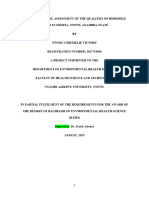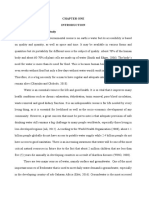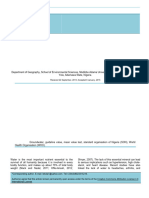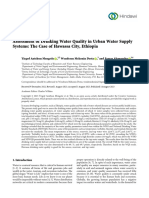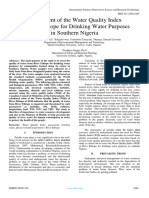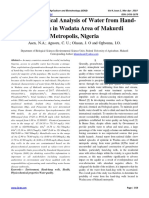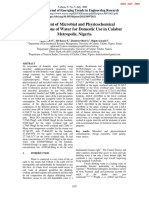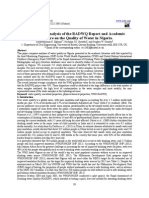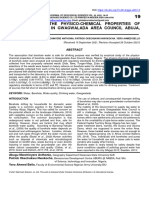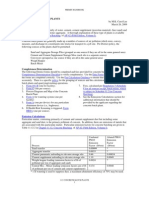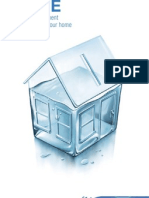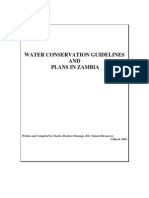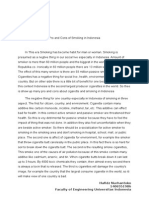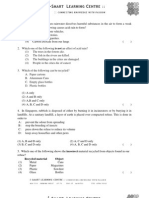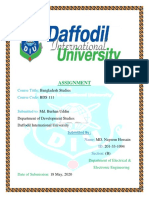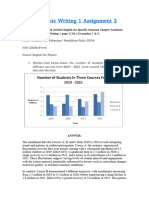Assessment of Water Quality of Hand-Dug Wells in Zaria LGA of Kaduna State, Nigeria
Assessment of Water Quality of Hand-Dug Wells in Zaria LGA of Kaduna State, Nigeria
Uploaded by
theijesCopyright:
Available Formats
Assessment of Water Quality of Hand-Dug Wells in Zaria LGA of Kaduna State, Nigeria
Assessment of Water Quality of Hand-Dug Wells in Zaria LGA of Kaduna State, Nigeria
Uploaded by
theijesOriginal Title
Copyright
Available Formats
Share this document
Did you find this document useful?
Is this content inappropriate?
Copyright:
Available Formats
Assessment of Water Quality of Hand-Dug Wells in Zaria LGA of Kaduna State, Nigeria
Assessment of Water Quality of Hand-Dug Wells in Zaria LGA of Kaduna State, Nigeria
Uploaded by
theijesCopyright:
Available Formats
The International Journal Of Engineering And Science (IJES) ||Volume||2 ||Issue|| 11||Pages|| 01-04||2013|| ISSN(e): 2319 1813 ISSN(p):
: 2319 1805
Assessment of Water Quality of Hand-Dug Wells in Zaria LGA of Kaduna State, Nigeria
By Samuel Yakubu
Department of Geography, Osun State University, Okuku Campus, Nigeria
----------------------------------------------------ABSTRACT--------------------------------------------This study assessed the water quality of some hand-dug wells in Zaria Local Government Area of Kaduna State, Nigeria. Water samples were collected from eight (8) different wells at strategic positions and determined to ascertain how safe the water is for directly human consumption without treatment. The physical and chemical parameters assessed include temperature, pH, total hardness, biochemical oxygen demand (BOD), nitrate, manganese, iron, copper, zinc, lead and nickel. The result revealed high variation between the WHO standard for potable water and the obtained values. The implication is that water from most wells in the study area is not in any way safe nor suitable for direct human consumption. Closeness of wells to refuse dumpsites was blamed for the increase levels of concentration of pollutants. To avoid further pollution of groundwater, the study therefore recommends that the site for well should be at least 30m away from source of contamination most especially refuse dumpsite, the surrounding environment of the existing wells should be kept clean and tidy to avoid or reduce contaminations, disinfection of wells water by chlorination and continuous monitoring to determine any change in the level of pollution at the sources.
KEYWORDS: water quality, pollutants, hand-dug wells, suitability
---------------------------------------------------------------------------------------------------------------------------------------Date of Submission: 05 November, 2013 Date of Acceptance: 30 November 2013 --------------------------------------------------------------------------------------------------------------------------------------I. INTRODUCTION Water is a resource that is both invaluable and vital to the existence of all living organisms, but this valued resource is increasingly being threatened as human populations grow and demand more water of high quality for domestic purposes and economic activities. Water value is linked to the provision and quality of ecosystems service. According to Annan, (2003) portable water is precious, we cannot live without it and human activities have profound impact on the quality and quantity of water available. Domestic water is used for drinking, cooking, bathing and cleaning, however, access to safe drinking and sanitation is critical in terms of health. For instance, unsafe drinking water contributed to numerous health problems in developing countries such as the one billion or more incidents of diarrhoea that occur annually (Mark et al., 2002). While water may appear to be clear and pure, and has no specific taste or odor, it may contain elements that can have undesirable effects on health. Water is classified under two main categories based on its location and these are surface and ground water (Appelo and Postma, 2005). The quality of any body of surface or ground water is a function of either or both natural influences and human activities. Without human influences, water quality would be determined by the weathering of bedrock minerals, atmospheric processes of evapotranspiration, and the deposition of dust and salt by wind. Others include, the natural leaching of organic matter and nutrients from soil, hydrological factors that lead to runoff, and by biological processes within the aquatic environment that can alter the physical and chemical composition of water (UNEP, 2006). Contrary to widely held theoretical view of groundwater being the safest water, wells are found to be polluted in terms of temperature, mineral contents, particles solute, organic matter and bacterial concentration. The quality of groundwater is determined by testing various parameters of interest on which results is compared with the standard qualities required for water intended for human consumption and use (Appelo and Postma, 2005). A well is an excavation or structure created in the ground aquifers. The well water is drawn by a pump, or using containers such as rubber or iron bucket that are raised by hand. Well can vary greatly in depth, water volume and may require treatment to soften it. Several studies such as Dada (1988), Abdullahi (1989), Akungbo (1990), Gideon (1999), (Folorunsho, 2010), Adediji and Ajibade, (2005) among others showed the relationship between ground (well) water quality and refuse dumpsites. For instance, Dada (1988) studied the faecal
www.theijes.com
The IJES
Page 1
Assessment Of Water Quality Of Hand
pollution of well water in Zaria city; Abdullahi (1989) worked on the isolation and identification of salmonella typhoid and vibro-cholerae from wells in Zaria. Ariziki (1991) in his study of some physiochemical and bacteriological qualities of shallow wells in Samaru, Zaria observed that polluted water wells of Samaru were due to poor location of such wells. Gideon (1999) studied the quality of water in wells found in Samaru, Zaria and observed that all the wells were polluted with pollution strength varying with locational qualities, land use and well construction design. He also observed seasonal variation in the pollution which he attributed to high total bacteria count levels in wells. Inadequate access to portable water is closely associated related to poverty (Taylor et al, 2002). In Ghana for instance, only 6% of the poorest wealth quintile had indoor piping compared with 78% of the wealthiest (Songsore and McGranahan, 1993). Various shallow wells have been sunk in the study area due to inadequate potable water supply. Water consumed plays a key role in determining the physical, mental and social health of any one (Yakubu and Baba, 2010). While human senses can only analyze the aesthetic quality of water, it cannot go beyond that to ascertain the chemical quality of drinking water. As a result, the overall process of evaluating the physical characteristic and elemental concentration of heavy metals contained in drinking water is expedient. The objective of the study is to determine some physical and chemical characteristics of well water consumed and to compare the parameters with the WHO standards in order to evaluate any possible health effect on the consumers. This is very important because drinking water quality guidelines and standards are designed to enable the provision of clean and safe water for human consumption, thereby protecting human health as well as the environment. The guidelines are usually based on scientifically acceptable levels of toxicity to either humans or aquatic organisms. Water quality is not static over time, rather, it vary in both time and space and requires routine monitoring to detect spatial patterns and changes over time.
II.
METHODOLOGY
The study area The study area is Zaria which lies on latitudes 11 07N and 12 00N, and longitude 07 44E and 8 00E. Located at a distance of about 962 kilometers from the Atlantic Ocean, it is about 80 kilometers from Kaduna (the state capital). Zaria lies at a height of about 700 metres above sea level and is part of the Hausa High Plains of the northern Nigeria. The area falls within the tropical wet-dry climate and experiences two distinct seasons namely; the wet and dry seasons which are caused by the movement of the Inter-Tropical Discontinuity (ITD) under the influence of two major air masses namely the tropical continental (cT) and the tropical maritime (mT). It has a mean annual rainfall of about 800mm, concentrated in a wet season between April and October (Yakubu, 2009). The temperature is high throughout the year, with the monthly mean rising from January (21 0C) and attaining a maximum in April (290C). A decade mean annual temperature (1999-2008) is 26oC (Yakubu, 2009). Zaria is drained majorly by Galma River with three other rivers as its tributaries which are River Kubanni, Shika and Saye. Data collection and Analysis Water samples were collected from eight (8) wells (w1-w8) in households at specific locations. The wells were basically considered as of small, medium and large sizes given the common sizes of wells in most homes in the study area. A small plastic bottle of one (1) litre capacity rinsed with distilled water was used to collect water samples. Water sample collected from each well was taken to the laboratory for analysis the same day for the following parameters: temperature, pH, total hardness, BOD, nitrate, copper, iron, manganese, zinc, lead and nickel using standard laboratory techniques. The analysis was carried out at the Centre for Energy Research and Training (CERT), Ahmadu Bello University, Zaria, Nigeria. The results obtained were compared with the secondary data gotten from publications of the World Health Organization (WHO) Standard to ascertain conformity with the national and international guidelines. Results and Discussion From the analysis of the samples, variations in the levels of both physical and chemical concentration were observed. The values of each of the parameters examined from well 1 to well 8 are tabulated in table 1. However, Table 2 which is the summary of data in Table 1 shows the variation in terms of range, mean level of concentration of each parameter examined, WHO standard and deviation from the standards. From Table 2, the results show that most parameters tested were either above or below the international and national standards with the exception of pH, which fall within the range. The mean value of temperature for instance is 25.3 which is above the WHO standard. A high temperature causes thermal pollution and adversely affects aquatic life. More so, a rising water temperature lowers the viscosity of water and so causes faster settling of solid particles. Total hardness has the mean concentration of 197.9mg/l higher than the 100mg/l WHO standard. This excess according to Appello and Postma (2005) causes cataract, diuretics disease and diarrhea in man and scouring disease among livestock.
www.theijes.com
The IJES
Page 2
Assessment Of Water Quality Of Hand
Table 1: Values of Well Water Sample
Parameter Temperature (oC) pH Total Hardness BOD Nitrate (mg/l) Manganese (mg/l) Iron (mg/l) Copper (mg/l) Zinc (mg/l) Lead (mg/l) Nickel (mg/l) W1 24.0 7.8 200 15 1.2 2.02 3.20 2.10 0.52 0.1 0.04 W2 25.5 7.5 182 20 1.8 0.84 1.14 2.40 0.18 0.07 0.05 W3 25.8 6.8 150 18 1.5 1.03 5.25 1.80 1.21 0.5 0.07 W4 24.4 8.0 302 20 1.7 0.42 2.88 0.82 0.56 0.03 0.12 W5 26.9 7.4 242 16 2.0 0.80 1.90 4.30 2.11 0.08 0.06 W6 25.6 7.8 132 18 1.7 2.33 4.20 1.44 1.42 1.00 0.09 W7 26.9 7.3 250 21 1.6 1.80 3.50 2.51 1.90 0.04 0.02 W8 23.8 7.0 125 12 1.5 2.20 0.72 1.80 1.12 0.85 0.03
Note: W = well Table 2: Suitability of drinking water quality Parameters Range Mean WHO Standard (2004) 23.5 6.5 - 8 500 10 1.5 0.4 0.3 1.0 5.0 0.01 0.02 Deviation
Temperature pH Total Hardness BOD Nitrate Manganese Iron Copper Zinc Lead Nickel
22.6 - 8.0 6.8 8.0 125 - 302 12 - 21 1.2 2.0 0.422.33 0.75-5.25 0.82-4.30 0.18-2.11 0.04-1.0 0.02-0.12
25.3 7.45 197.9 17.5 1.63 1.43 2.85 2.15 1.13 0.33 0.06
+1.81 +0.95, -0.55 -302.3 +7.5 +0.13 +1.03 +2.55 +1.12 -3.88 +0.32 +0.04
Field observation, the contamination or high levels of heavy metal content observed in the selected wells could be attributed to the indiscriminate dumping of refuse around most of the wells, which could leached down from the surface. Several other studies such as Akungbo (1990); Ariziki (19991), Gideon (1999), (Folorunsho, 2010) revealed that refuse dumps distance is not the only factor responsible for the level of concentration of pollutants in wells. Other factors such as nature of the geologic material developed on the poorly weathered crystalline basement complex rocks, poor drainage and sewage systems, discharge from industries and application of fertilizers could also be responsible for the level of pollution in the well water. The health risk with manifesting symptoms of acute toxicity is only associated with known exposure and or ingestion. While heavy metals reaching toxic levels have health risks associated with it, some symptoms associated with this health risk are experienced by some consumers and it is an indication that ill-health affect efficiency in one way or the other (Yakubu and Baba, 2010). Similarly, Okechukwu et al (2012) reported rampant cases of water borne diseases like typhoid fever in some hospitals in Nsukka metropolis. It is obvious that this common resource - water brings with it the blessing of continual survival but where carelessly handled is accompanies with it a silent epidermic, capable of hindering the attainment of individuals goal, wrecking havoc to the society' potential labour force and thus becomes the bane of national development.
III.
CONCLUSION
From the study, it is observed that the water quality of the eight wells present a vivid picture of the nature of pollutants found in the well water where many consumers relay on. Based on the WHO standard for safe drinking water, most of the wells are in critical state of pollution. This means that water from most wells is not in any way suitable for direct consumption as practiced in the area. However to avoid further pollution of groundwater, the study therefore recommends that the site of any well to be dug should be at least 30m away from any source of contamination, the surrounding environment should be kept clean and tidy to avoid or reduce contaminations from dirt around the wells, disinfection of wells water by chlorination and continuous monitoring to determine any change in the level of pollution at the sources.
www.theijes.com
The IJES
Page 3
Assessment Of Water Quality Of Hand REFERENCE
[1] [2] [3] [4] [5] [6] [7] [8] [9] Adediji, A. and Ajibade, L.T. (2005). Quality of Well Water in Ede Area, Southwestern Nigeria. J. Hum. Ecol.,17(3): 223-228. Akungbo, A. (1990) Pollution of water in Samaru, Unpublished Dissertation Department of Geography Ahmadu Bello University Zaria, Nigeria. Annan, K. (2003) On: World Water Day, Special United Nation Report, March, 2003 Appelo, C.A.J. and Posma, D.C. (2005). Geochemistry of Groundwater and Pollution Published by Balkema,Leiden. Ariziki, A.L. (1991) Some Bacteriological and Physiochemical Qualities of Shallow wells in Samaru, Zaria, Unpublished Dissertation Department of Geography Ahmadu Bello University Zaria, Nigeria. Folorunsho, J.O. (2010). An assessment of the quality of water in shallow wells in Sabon-Gari, Zaria, Kaduna State. The Zaria Geographer, 18(1); 71-82. Gideon, R.K. (1999). An Assessment of Current Level of Pollution of Hand-dug wells in Samaru Zaria, Unpublished Dissertation Department of Geography Ahmadu Bello University Zaria, Nigeria. Mark, W.R., Ximing Cai and Sarah A.C. (2002): World Water and Food to 2025: Dealing with Scaraty. International Food Policy Research Institute, NW, Washington, DC, USA. Okechukwu M.E., Ogwo V., Onuegbu C.U. and Mbajiorgu C.C. (2012). Water Quality Evaluation of Spring Waters in Nsukka, Nigeria. In Hydrology for Disaster Management; Special Publication of the Nigerian Association of Hydrological Sciences, pp 224-230. Songsore, J. and McGranahan, G. (1993). Environmental, Wealth and Health: towards an Analysis of Intral -urban Differentials within the Greater Accra Metropolitant Area, Ghana. Environment and Urbanization 5, pp 10-34. Taylor, P. Boussen, C.R., Awunyo-Akaba, J. and Nelson, J. (2002). Ghana Urban Health Assessment. Environmental Health Project Activity Report No. 114, Washington DC. USAID. United Nations Environment Program (UNEP) (2006). Water Quality for Ecosystem and Human Health, United Nations Environment Program/Global Environment Monitoring System (UNEP/GEMS) Program 2006, pp 1-132. World Health Organization (WHO) (2004). Standard for drinking water. Yakubu, S. (2009). Effects of municipal soil waste application on soil properties and crop qualities in Zaria urban area northern Nigeria. PhD. Thesis, Dept of Geog. University of Abuja. Yakubu, S. and Baba, B. (2010). Assessment of water quality consumed by students and its health implications on their academi c performance. Journal of Studies in Science and Mathematic Education, 1(1), 103-111.
[10] [11] [12] [13] [14] [15]
www.theijes.com
The IJES
Page 4
You might also like
- Final Corrections On The Full - Project - Nwosu - VictoryDocument72 pagesFinal Corrections On The Full - Project - Nwosu - Victoryjolenebakers0No ratings yet
- Water Quality Assessment PR2 FinalDocument22 pagesWater Quality Assessment PR2 FinalPeteisaiah CopadaNo ratings yet
- GC Column and Method GuideDocument1 pageGC Column and Method GuidezaedmohdNo ratings yet
- W0210200204 PDFDocument5 pagesW0210200204 PDFAJER JOURNALNo ratings yet
- An Assessment of The Physicochemical Qualities of Water Sources in Kano Metropolis, Nigeria BY Boyi, S., Yusuf, Y.O., Sawa, B.A. and Adegbehin, A.BDocument12 pagesAn Assessment of The Physicochemical Qualities of Water Sources in Kano Metropolis, Nigeria BY Boyi, S., Yusuf, Y.O., Sawa, B.A. and Adegbehin, A.BSuleiman MukhtarNo ratings yet
- Physicochemical Analyses of Hand-Dug Well Water in Egunughan Community, South-Western NigeriaDocument4 pagesPhysicochemical Analyses of Hand-Dug Well Water in Egunughan Community, South-Western NigeriaIOSRjournalNo ratings yet
- Ad2689e59826 PDFDocument7 pagesAd2689e59826 PDFAdebanjo Adeshina SamuelNo ratings yet
- Chapter One 1.1 Background To The StudyDocument57 pagesChapter One 1.1 Background To The StudyInspiration MediaNo ratings yet
- Eniola SeminarDocument14 pagesEniola Seminarkennedy NkitikporNo ratings yet
- Assessment of Groundwater Quality For Drinking and IrrigationDocument9 pagesAssessment of Groundwater Quality For Drinking and Irrigationsubhankar ghoshNo ratings yet
- Ajol File Journals - 389 - Articles - 113442 - Submission - Proof - 113442 4633 315985 1 10 20150223Document12 pagesAjol File Journals - 389 - Articles - 113442 - Submission - Proof - 113442 4633 315985 1 10 20150223oboyiecheofun01No ratings yet
- Paper Corrected-08.03.2024Document25 pagesPaper Corrected-08.03.2024prashanNo ratings yet
- Hydrogeological Characteristics and Groundwater Quality Analysis For Selected Boreholes in Ogbaru Local Government Area, Anambra State, NigeriaDocument13 pagesHydrogeological Characteristics and Groundwater Quality Analysis For Selected Boreholes in Ogbaru Local Government Area, Anambra State, Nigeriadamiajibade634No ratings yet
- 109-ArticleText-342-1-10-202301301Document11 pages109-ArticleText-342-1-10-202301301m8hnd9qpnhNo ratings yet
- Research Article: Assessment of Drinking Water Quality in Urban Water Supply Systems: The Case of Hawassa City, EthiopiaDocument15 pagesResearch Article: Assessment of Drinking Water Quality in Urban Water Supply Systems: The Case of Hawassa City, EthiopiaHabtamu GeremewNo ratings yet
- CHIDUBEM EHS PROJECT CHAPTER ONEDocument6 pagesCHIDUBEM EHS PROJECT CHAPTER ONEErhueh Kester AghoghoNo ratings yet
- Nicholas Cie ProjectDocument25 pagesNicholas Cie ProjectErhueh Kester AghoghoNo ratings yet
- The Hydrogeochemical Signatures Quality Indices AnDocument19 pagesThe Hydrogeochemical Signatures Quality Indices AnUnigwe Chinanu OdinakaNo ratings yet
- Water Quality Assessment of Coca-Cola Wastewater Reservoir in Maiduguri Borno State NigeriaDocument5 pagesWater Quality Assessment of Coca-Cola Wastewater Reservoir in Maiduguri Borno State NigeriaIOSRjournal100% (1)
- Amoo GroundwaterDocument6 pagesAmoo GroundwaterMd Shoriful IslamNo ratings yet
- Assessment of The Water Quality Index of River Ethiope For Drinking Water Purposes in Southern NigeriaDocument7 pagesAssessment of The Water Quality Index of River Ethiope For Drinking Water Purposes in Southern NigeriaInternational Journal of Innovative Science and Research TechnologyNo ratings yet
- Assessment of Otamiri Water Quality For Agricultural and Domestic UsesDocument68 pagesAssessment of Otamiri Water Quality For Agricultural and Domestic Usesjamessabraham2No ratings yet
- Physico-Chemical Analysis of Water From Hand-Dug Wells in Wadata Area of Makurdi Metropolis, NigeriaDocument5 pagesPhysico-Chemical Analysis of Water From Hand-Dug Wells in Wadata Area of Makurdi Metropolis, NigeriaIJEAB JournalNo ratings yet
- Assessment of The Physico Chemical PropeDocument7 pagesAssessment of The Physico Chemical PropeAchionye IkechukwuNo ratings yet
- Ali Raza PublicationDocument8 pagesAli Raza Publicationhussainfazal090No ratings yet
- Dohuk DamDocument10 pagesDohuk DamKhairi Ali OmarNo ratings yet
- Assessment of Microbial and Physicochemical Contaminations of Water For Domestic Use in Calabar Metropolis, NigeriaDocument5 pagesAssessment of Microbial and Physicochemical Contaminations of Water For Domestic Use in Calabar Metropolis, NigeriaWARSE JournalsNo ratings yet
- Sunil Kumar Tank, R. C. Chippa. Analysis of Water Quality of Halena Block in Bharatpur AreaDocument9 pagesSunil Kumar Tank, R. C. Chippa. Analysis of Water Quality of Halena Block in Bharatpur AreaDr. Krishna N. SharmaNo ratings yet
- Effects of Human Activities On Water Quality AssesDocument9 pagesEffects of Human Activities On Water Quality AssesOlayinka Femi-FadeyiNo ratings yet
- Quality Assessment of Selected: June 2020Document18 pagesQuality Assessment of Selected: June 2020adegolaadebowalebNo ratings yet
- Early Wet Season Quality Assessment of Water Sources From Selected Cities in Rivers State NigeriaDocument29 pagesEarly Wet Season Quality Assessment of Water Sources From Selected Cities in Rivers State NigeriaobiomaNo ratings yet
- D 010212433Document10 pagesD 010212433IOSRjournalNo ratings yet
- Suitability Assessment of Groundwater For Drinking and Irrigation UseDocument8 pagesSuitability Assessment of Groundwater For Drinking and Irrigation UseIOSRjournalNo ratings yet
- A Global Water Quality Index and Hot-Deck Imputation of Missing DataDocument12 pagesA Global Water Quality Index and Hot-Deck Imputation of Missing DatamaizansofiaNo ratings yet
- Evaluation of Quality and Irrigation Characteristics of Surface Water From Okochiri Creek in Rivers State NigeriaDocument14 pagesEvaluation of Quality and Irrigation Characteristics of Surface Water From Okochiri Creek in Rivers State NigeriaInternational Journal of Innovative Science and Research TechnologyNo ratings yet
- Evaluation of Water Quality Index Levels and HumanDocument19 pagesEvaluation of Water Quality Index Levels and HumanPrince AkangNo ratings yet
- Effect of Mining Activities On Groundwater Quality in Ikwo Local Government Area of Ebonyi State, NigeriaDocument13 pagesEffect of Mining Activities On Groundwater Quality in Ikwo Local Government Area of Ebonyi State, NigeriaInternational Journal of Innovative Science and Research TechnologyNo ratings yet
- Application of Water Quality Index For Assessment of Dokan Lake Ecosystem Kurdistan Region IraqDocument7 pagesApplication of Water Quality Index For Assessment of Dokan Lake Ecosystem Kurdistan Region IraqMy Friend friendNo ratings yet
- Comparative Analysis of The RADWQ Report and AcademicDocument16 pagesComparative Analysis of The RADWQ Report and AcademicAlexander DeckerNo ratings yet
- 6 Physico Chemical Analysis of Ground Water For Domestic Use in Some Selected Communities in Minna by Saidu M. Et AlDocument11 pages6 Physico Chemical Analysis of Ground Water For Domestic Use in Some Selected Communities in Minna by Saidu M. Et AlAwomuse JoelNo ratings yet
- PHD Proposal On Sustainable EnvironmentDocument10 pagesPHD Proposal On Sustainable EnvironmentkankonsultiumNo ratings yet
- 310 FJST 8 (1) pp+37-45Document9 pages310 FJST 8 (1) pp+37-45engdasewNo ratings yet
- Effects of Abattoir Activities On The Water Quality of Oko-Oba River in Agege, Lagos, Nigeria: A Seasonal Variation AssessmentDocument20 pagesEffects of Abattoir Activities On The Water Quality of Oko-Oba River in Agege, Lagos, Nigeria: A Seasonal Variation AssessmentSegunNo ratings yet
- Ajassp 2010 453 458Document7 pagesAjassp 2010 453 458SahanaNo ratings yet
- Assessment of Bottled Water Quality Using Physico-ChemicalDocument13 pagesAssessment of Bottled Water Quality Using Physico-ChemicalKenneth Wilson SiNo ratings yet
- Assessment of Groundwater Quality For Human UsesDocument10 pagesAssessment of Groundwater Quality For Human UsesInternational Journal of Innovative Science and Research TechnologyNo ratings yet
- Ogun Water QualityDocument13 pagesOgun Water QualityOladipupo McDonstep OlafusiNo ratings yet
- Groundwater Pollution ThesisDocument7 pagesGroundwater Pollution Thesislanasorrelstulsa100% (2)
- Assessment of Groundwater Quality in The Western Part of Bayero University New Campus and It's EnvironsDocument7 pagesAssessment of Groundwater Quality in The Western Part of Bayero University New Campus and It's EnvironsAbdussalam Muhammad AuwalNo ratings yet
- TMP 2 F56Document10 pagesTMP 2 F56FrontiersNo ratings yet
- Determination of Toxic and Trace Elements in WaterDocument7 pagesDetermination of Toxic and Trace Elements in WaterBaaba JiNo ratings yet
- Ajol File Journals - 103 - Articles - 230950 - Submission - Proof - 230950 1225 560510 1 10 20220831Document6 pagesAjol File Journals - 103 - Articles - 230950 - Submission - Proof - 230950 1225 560510 1 10 20220831Ojan Benard LeoNo ratings yet
- Field Investigation of Spread of Conductivity and Its Effect On Underground Water With GIS ApplicationDocument59 pagesField Investigation of Spread of Conductivity and Its Effect On Underground Water With GIS ApplicationTamarakuro Simon AlaleNo ratings yet
- Physico-Chemical Analysis of Water Sources in Awka-Urban, Anambra StateDocument3 pagesPhysico-Chemical Analysis of Water Sources in Awka-Urban, Anambra StateInternational Journal of Innovative Science and Research TechnologyNo ratings yet
- Physicochemical and Microbiological Analysis of Water Bodies in Uturu, Abia State-NigeriaDocument8 pagesPhysicochemical and Microbiological Analysis of Water Bodies in Uturu, Abia State-NigeriaDivakar SaiNo ratings yet
- Water Sources and Water-Borne Diseases: A Study of Seasonal Disparities in Bacteriological Compositions of Water Sources in Kogi State, NigeriaDocument6 pagesWater Sources and Water-Borne Diseases: A Study of Seasonal Disparities in Bacteriological Compositions of Water Sources in Kogi State, NigeriaIJAR JOURNALNo ratings yet
- A Study On Physico-Chemical Properties of Ground Water Quality of Various Locations of Kanpur CityDocument3 pagesA Study On Physico-Chemical Properties of Ground Water Quality of Various Locations of Kanpur CityNeerja ShuklaNo ratings yet
- PHD Thesis On Groundwater Quality AssessmentDocument7 pagesPHD Thesis On Groundwater Quality Assessmentdwfz48q3100% (2)
- Shigut2017 Article AssessmentOfPhysico-chemicalQuDocument10 pagesShigut2017 Article AssessmentOfPhysico-chemicalQuofarmNo ratings yet
- Analysis of The Impact of Anthropic Activities On The Water Chemistry of Weathered Layer Aquifer of M'bahiakro Locality (Center of Côte D'ivoire)Document7 pagesAnalysis of The Impact of Anthropic Activities On The Water Chemistry of Weathered Layer Aquifer of M'bahiakro Locality (Center of Côte D'ivoire)AJER JOURNALNo ratings yet
- Ecohydrology: Vegetation Function, Water and Resource ManagementFrom EverandEcohydrology: Vegetation Function, Water and Resource ManagementNo ratings yet
- Defluoridation of Ground Water Using Corn Cobs PowderDocument4 pagesDefluoridation of Ground Water Using Corn Cobs PowdertheijesNo ratings yet
- Development of The Water Potential in River Estuary (Loloan) Based On Society For The Water Conservation in Saba Coastal Village, Gianyar RegencyDocument9 pagesDevelopment of The Water Potential in River Estuary (Loloan) Based On Society For The Water Conservation in Saba Coastal Village, Gianyar RegencytheijesNo ratings yet
- Mixed Model Analysis For OverdispersionDocument9 pagesMixed Model Analysis For OverdispersiontheijesNo ratings yet
- Design and Simulation of A Compact All-Optical Differentiator Based On Silicon Microring ResonatorDocument5 pagesDesign and Simulation of A Compact All-Optical Differentiator Based On Silicon Microring ResonatortheijesNo ratings yet
- Influence of Air-Fuel Mixtures and Gasoline - Cadoba Farinosa Forskk Bioethanol Fuel Mixtures On Emissions of A Spark - Ignition Engine.Document9 pagesInfluence of Air-Fuel Mixtures and Gasoline - Cadoba Farinosa Forskk Bioethanol Fuel Mixtures On Emissions of A Spark - Ignition Engine.theijesNo ratings yet
- Dalton Delivery Service - W Union BLVD Tanker AccidentDocument2 pagesDalton Delivery Service - W Union BLVD Tanker AccidentJulian AbrahamNo ratings yet
- Science Standards NC 7th GradeDocument14 pagesScience Standards NC 7th Gradeapi-369419673No ratings yet
- Environmental Science Module 1Document28 pagesEnvironmental Science Module 1Aila Jane Olano VestidasNo ratings yet
- 11.5 Concrete Batch Plants: Emission CalculationsDocument4 pages11.5 Concrete Batch Plants: Emission CalculationsNaeem KhanNo ratings yet
- XXL Size Recovery Boilers WhitepaperDocument11 pagesXXL Size Recovery Boilers WhitepaperMario MeloNo ratings yet
- H2OMEDocument36 pagesH2OMEczackwaltzNo ratings yet
- Intermediate 1 - Final ExamDocument8 pagesIntermediate 1 - Final ExamXimena Serrano BalboaNo ratings yet
- 2222Document5 pages2222Roberto UrrutiaNo ratings yet
- 6 Activated Sludge Process PDFDocument61 pages6 Activated Sludge Process PDFVineet ChaudharyNo ratings yet
- Case Study Coca ColaDocument8 pagesCase Study Coca ColamohyNo ratings yet
- Summative Test-Biodiversity - Mod5Document2 pagesSummative Test-Biodiversity - Mod5lavenia acdalNo ratings yet
- Busn 179 Ip - Marcus and Millichap FinalDocument10 pagesBusn 179 Ip - Marcus and Millichap Finalapi-381521210No ratings yet
- Msds EthaneDocument7 pagesMsds Ethanenirmal_subudhiNo ratings yet
- Guidelines For PrimeCoat and Tack CoatDocument111 pagesGuidelines For PrimeCoat and Tack CoatBalasubramanian Mahadevan100% (1)
- Water Conservation Guidelines and Plans in ZambiaDocument56 pagesWater Conservation Guidelines and Plans in ZambiaCharles ChisangaNo ratings yet
- Pro and Cons of Smoking in IndonesiaDocument2 pagesPro and Cons of Smoking in IndonesiaHafidz NurhantokoNo ratings yet
- Indoor Air Quality ChecklistDocument3 pagesIndoor Air Quality ChecklistHumaid ShaikhNo ratings yet
- P6 Man and Environment Worksheet (Student Copy)Document17 pagesP6 Man and Environment Worksheet (Student Copy)John John AppleseedNo ratings yet
- BDS AssignmentDocument10 pagesBDS AssignmentNayeem HossainNo ratings yet
- Water Balance & Sources of Wastewater in Sugar Mill & RefineryDocument20 pagesWater Balance & Sources of Wastewater in Sugar Mill & RefineryArun Gupta0% (1)
- Praestol A 3015 L R27062007 en (TDS)Document2 pagesPraestol A 3015 L R27062007 en (TDS)Pablo Martínez BerenguerNo ratings yet
- TSPSC Pollution Board SyllabusDocument3 pagesTSPSC Pollution Board SyllabusCharan Reddy100% (1)
- GREENWASHINGDocument14 pagesGREENWASHINGSonali SharmaNo ratings yet
- Academic Writing 1 Assignment 2 - Stefanus Kolondam - 23030184145Document3 pagesAcademic Writing 1 Assignment 2 - Stefanus Kolondam - 23030184145Stefanus KolondamNo ratings yet
- Environmental ChangeDocument6 pagesEnvironmental Changeapi-412292584No ratings yet
- Great Britain: 1. Geography and GeologyDocument4 pagesGreat Britain: 1. Geography and GeologySvetlana ĐurkinjakNo ratings yet
- Thesis PartDocument4 pagesThesis PartJeetender555No ratings yet
- Ganga PollutionDocument14 pagesGanga PollutionEr. Hisham Ajmal PCNo ratings yet
- ReportDocument20 pagesReportteko denisNo ratings yet
